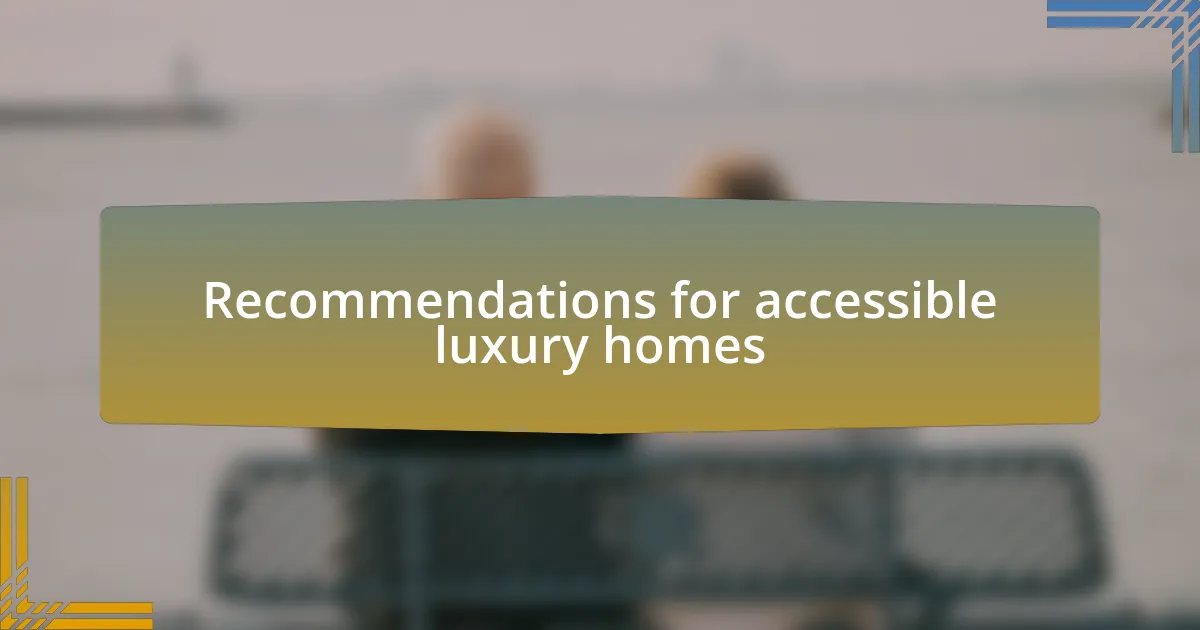Key takeaways:
- Luxury retirement homes enhance quality of life through amenities, community spaces, and safety features.
- Accessibility is essential for engagement, ensuring all residents can participate in activities and enjoy their environment.
- Thoughtful design elements, like smooth pathways and adaptable communal areas, promote independence and dignity.
- Evaluating individual accessibility needs fosters inclusivity and enhances the overall living experience for residents.

Understanding luxury retirement homes
Luxury retirement homes often provide amenities that go beyond basic needs, catering to the desires and comforts of residents. During my visits, I’ve seen beautifully landscaped gardens and elegant communal spaces designed for social gatherings, which foster a strong sense of community. How often do we overlook the importance of these environments in enhancing our quality of life as we age?
Additionally, these homes typically feature high-end amenities like gourmet dining options and full-service wellness programs. I recall a lovely afternoon spent chatting with residents who shared their favorite meals, crafted by talented chefs right on site. It was heartwarming to see how these culinary experiences not only nourished their bodies but also enriched their social lives.
Moreover, luxury retirement homes prioritize safety and security, incorporating the latest technology to ensure peace of mind for residents and their families. I once had a heart-to-heart conversation with a nurse about the intricate systems they have in place; it became clear that these measures allow residents to live more freely while feeling protected. Isn’t it comforting to know that safety doesn’t have to compromise the enjoyment of life in these beautiful settings?

Importance of venue accessibility
Accessibility is a crucial aspect of luxury retirement homes, ensuring that all residents can navigate their surroundings comfortably and safely. I remember visiting a beautifully designed space where wide hallways and ramps were thoughtfully integrated, allowing everyone, including those with mobility challenges, to enjoy the full experience of the facility. It made me reflect: how often do we take for granted the simple ability to move freely in our environment?
I’ve seen firsthand how accessible venues contribute to a vibrant community atmosphere. During one visit, I noticed a resident in a wheelchair easily joining a group for a game night. Their laughter filled the room, reinforcing the idea that accessibility fosters connection, making everyone feel included. Isn’t that what we all seek in our golden years—a sense of belonging and engagement?
In my experience, the impact of venue accessibility extends beyond physical ease; it enhances the overall quality of life. I spoke with a resident who shared how the accessible design allowed her to pursue hobbies like gardening, connecting her with nature and her neighbors. This interplay of accessibility and personal fulfillment highlights why it’s vital for luxury retirement homes to prioritize such thoughtful planning. How can we truly elevate our living experience without considering the barriers that might exist?

Features of accessible venues
One of the standout features of accessible venues is the presence of thoughtfully designed pathways. I recall visiting a retirement community where the landscaped gardens were not only beautiful but also equipped with smooth, non-slip pathways. These kinds of elements allow residents, regardless of their mobility, to enjoy the outdoors freely. How empowering it must feel for someone to glide through the gardens, breathing in fresh air without a hint of worry about accessibility!
Restrooms in accessible venues are another critical feature that often gets overlooked. I was once in a luxury retirement home that had spacious, well-equipped restrooms with grab bars and ample turning space for wheelchairs. Witnessing an elderly resident confidently navigate those facilities filled my heart with joy. It was a reminder that dignity in the simplest aspects of our daily routines is essential. How often do we consider the ways these facilities enhance personal independence?
I also appreciate the significance of communal spaces that are designed for inclusivity. During my visits, I’ve seen dining areas with adjustable tables and flexible seating arrangements. This adaptability ensures that all residents can gather, share meals, and enjoy each other’s company. It’s these small yet substantial choices that create an inviting atmosphere. Who wouldn’t want to dine in a place where everyone feels welcome and engaged in lively conversation?

Personal experiences with venue access
Reflecting on my experiences with venue access, I vividly remember accompanying a friend to an upscale retirement center. The moment we arrived, I noticed the automatic doors that opened effortlessly, making her entrance smooth and dignified. It struck me how such a simple feature can transform feelings of anxiety into a sense of belonging. Isn’t it fascinating how the right design can change an experience entirely?
On another occasion, I attended an event at a luxury retirement home where every corner seemed to prioritize accessibility. I was particularly moved by the way the event staff engaged with residents who required assistance. The genuine smiles and willingness to help created a warm environment that felt inclusive. It made me wonder—how often do we consider the impact of human connection alongside physical accessibility?
I still recall a heartwarming moment in a beautifully designed lounge area, where a group of seniors shared stories over coffee. The seating was arranged to accommodate both wheelchairs and mobile residents, fostering a sense of unity. Witnessing their animated conversations reminded me that accessibility isn’t just about physical space; it’s about nurturing relationships. How often do we forget that the true essence of a venue lies in the connections we build within its walls?

Evaluating specific accessibility needs
Evaluating specific accessibility needs requires a deep understanding of individual circumstances. I once assisted a friend who uses a walker during a visit to a retirement community. As we navigated the space, I quickly realized that not all pathways accommodated mobility aids easily. It prompted me to ask: how can we ensure that environments are truly designed for everyone?
There was a moment I observed when a resident with hearing difficulties struggled to engage during a group activity. The lack of visual cues made it challenging for her to participate fully. This experience highlighted the importance of evaluating auditory accessibility alongside physical design. Why do we often overlook how essential it is for everyone to feel included in social settings?
On another visit, I noticed the range of amenities available. However, some features, like the dining area’s layout, created barriers for those with limited mobility. This made me wonder—how can we bridge the gap between luxury and accessibility? Evaluating specific needs goes beyond compliance; it’s about fostering an inclusive culture where all residents can thrive.

Recommendations for accessible luxury homes
When searching for accessible luxury homes, I suggest prioritizing communities that feature open floor plans. I recall visiting a high-end retirement facility where wide hallways and spacious living areas made a significant difference for residents using mobility devices. Could you imagine the comfort of knowing you can move freely without navigating tight corners or cramped spaces?
It’s also essential to look for properties that incorporate technology for enhanced accessibility. During one tour, I encountered homes equipped with smart home systems, allowing residents to control lighting and temperature without leaving their seats. This technology not only adds convenience but also empowers residents to maintain their independence. Have you ever thought about how much easier daily tasks can become with just a few smart features?
Additionally, I recommend assessing the availability of on-site services tailored for specific needs. I once spoke with a resident who shared how beneficial the in-house physical therapy programs were for her recovery. It struck me that having such resources close at hand can make all the difference in the quality of life for residents. So, when choosing a luxury retirement home, consider if these services integrate seamlessly with their overall lifestyle.

Sharing success stories of accessibility
One of my favorite success stories is about a retirement community that transformed its amenities to better serve residents with mobility challenges. A friend of mine moved into a luxury home that introduced innovative features after identifying accessibility gaps. She often shares how the addition of automatic doors and elevators not only made her daily routine easier but also fostered a sense of belonging among residents, creating an inclusive atmosphere that everyone appreciates. Can you imagine living in a place where every detail contributes to your comfort and independence?
Another notable instance comes to mind about a luxury retirement home that embraced creative solutions to promote accessibility. I visited a facility that installed tactile wayfinding paths and visual aids for residents with vision impairments. I was genuinely moved when I overheard a resident express her joy in being able to navigate the grounds confidently. This commitment to enhancing accessibility shows that small adjustments can lead to remarkable improvements in the overall experience. How powerful is it to witness such thoughtful changes in action?
Lastly, I can’t help but reflect on the success of social programs in accessible luxury homes. One resident shared how participating in adaptive exercise classes helped him regain strength and build new friendships. Seeing the smiles and energy in that room was incredibly uplifting. The realization that a supportive community can change lives reinforces the importance of accessibility in every aspect. How does it feel to know that together, we can create spaces where everyone thrives?